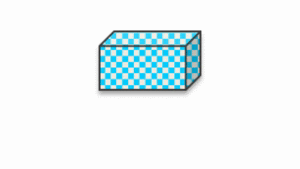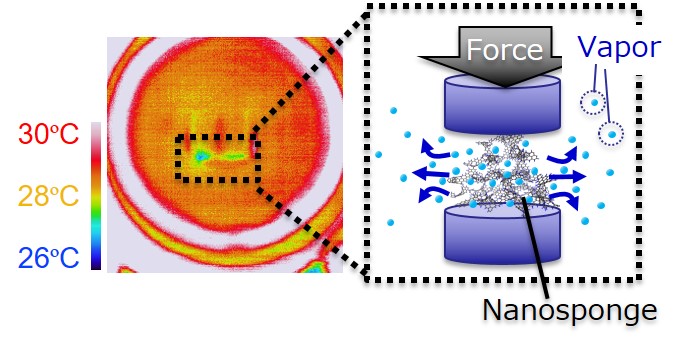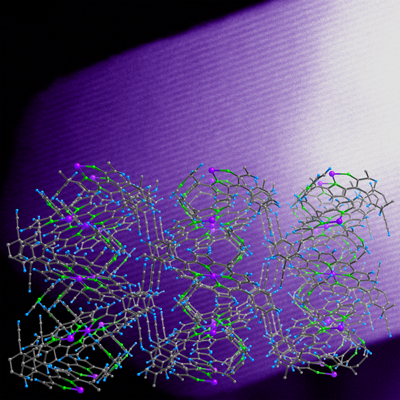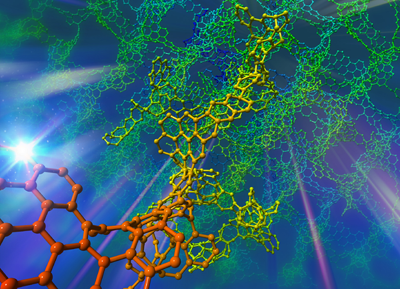弾性変形するナノ多孔体が引き起こす新しい物理化学現象
New physicochemical phenomena based on elastic nanoporous materials
単層グラフェンナノ多孔体は機械的に柔軟であり、スポンジのように可逆的に圧縮/復元を繰り返すことができます。50 nm以下の大きさのナノ細孔を大量にもちながら、スポンジのように柔軟に変形できる材料は非常に珍しく、本研究室ではこのような特徴をもつ材料を「ナノスポンジ」と名付け、応力により変形する「超空間」を利用した、新しい科学分野を切り拓いています。例えば、液体を含ませた柔軟ナノ多孔体を「絞る」ことで、液体を気体に相転移させることができ(Fig. 3)、潜熱による冷却・加熱の制御が可能となります(Fig. 4)。この原理を利用すれば、新しいタイプのヒートポンプを設計することができます。
Nanoporous materials with single-graphene walls are mechanically flexible, and they can be reversibly contracted and recovered like plastic sponges. Most of nanoporous materials are mechanically hard, and only a few types of nanoporous materials exhibit a large degree of deformation by mechanical force. We define such elastic nanoporous materials as 'nanosponges', and open the door of new physicochemistry based on the 'hyper nanospace' which can be deformed by mechanical force. For instance, it is possible to induce liquid-gas phase transition by squeezing nanosponges containing liquid (Fig. 3). Thus, the latent heat can be controlled by mechanical force, and this mechanism enables the design of a new type of heat pump.


有機化学的手法に基づく結晶性カーボン材料の創製と応用
Development of ordered carbonaceous frameworks synthesized based on organic chemistry
有機物を炭素化するとカーボン材料が得られますが、炭素化の過程の構造変化は非常に激しいため、原料の有機物の構造を分子レベルで維持することは困難です。近年、有機金属構造体(Metal-Organic Framework, MOF)などの結晶性物質を炭素化する研究が活発ですが、やはり元の結晶構造は崩壊し、得られるカーボン材料は非晶質になってしまいます。これに対し本研究室では、適切な分子設計により炭素化時の構造崩壊を抑制し、規則構造と分子レベルの化学構造を維持した規則性カーボン構造体(Ordered carbonaceous framework, OCF)の調製に成功しています(Fig. 5)。OCFはMOFのような結晶性多孔体とカーボン材料のハイブリッドであり、白金代替を含む新規の触媒材料としての応用を進めています。
Carbon materials are prepared by carbonization of organic precursors. During the carbonization process, the structure of a precursor is greatly changed, resulting in the formation of disordered and amorphous carbon structures. Recently, carbonization of crystalline materials like metal-organic frameworks (MOFs) has been intensively investigated, whereas only amorphous carbons have been synthesized. We have discovered a way to synthesize ordered carbonaceous frameworks (OCFs) which retain the structure regularity as well as molecular blocks of the precursor organic crystal (Fig. 5). OCFs are the hybrid of crystalline materials like MOFs and carbon materials, and we are developing new catalysts including alternatives for platinum catalysts.

カーボン系材料のヘルスケア分野への展開
Applications of carbon-based materials for healthcare field
当研究室では、カーボン系材料のヘルスケア分野への展開も進めています。その1つが、柔軟な微小開口ハニカム材料です。自動車のマフラー等に利用されているハニカムモノリスは押出成形により製造されていますが、その開口径は200μm程度が下限値であり、それ以下の微小化は困難でした。田門・向井・西原は2004年に氷晶を鋳型とした、開口径が5~200μmのハニカムモノリスの調製法を開発、さらに西原らは開口径を180 nmまで微小化することに成功しています。2016年、西原らはセルロースナノファイバーが微小開口ハニカム形成に極めて有効であることを発見、さらにグラフェンとの複合化によりスポンジのように柔軟に変形可能なハニカム材を調製しました。このユニークな微小開口ハニカム材のヘルスケア分野への応用を進めています。
We are developing healthcare applications using carbon-based materials. An example is flexible honeycomb monolith with micrometer channels. Honeycomb monoliths which are widely used for car mufflers are produced by extrusion molding, whereas the minimum channel size is restricted to about 200 micrometers. In 2004, Tamon, Mukai, and Nishihara developed a preparation method for honeycomb monoliths with channel sizes of 5 to 200 micrometers, via ice-templating approach. Moreover, Nishihara et al. succeeded in downsizing of channel size to 180 nm. In 2016, Nishihara et al. discovered a distinct structure-directing function of cellulose nanofibers for the microhoneycomb structures, and moreover, honeycomb monoliths with sponge-like flexibility were developed by compositing with graphene. We are developing a variety of healthcare applications using the honeycomb monoliths with micrometer straight channels and mechanical flexibility.

- 2023
-
ナノ細孔内部の現象解明に最適なモデル多孔電極
Unveiling the Nanoscale Frontier: Innovating with Nanoporous Model Electrodes
- 2023
-
リチウム空気電池を長寿命化するカーボン新素材を発見 従来のカーボン正極の劣化をグラフェンメソスポンジで克服
- 2023
-
3DC×東北大学 カーボン新素材GMSで「世界を変える」共創研究ラボ』の設置
- 2023
-
株式会社3DCについて
- 2023
-
「ゼオライト鋳型炭素」図版について(理化学研究所HP)
- 2022
-
スポンジ状カーボン新素材GMSの事業化 に向け、民間ファンド獲得 東北大発ベンチャーの3DCと組み、高性能電池などでの早期社会実装目指す
- 2022
-
スポンジ状カーボン新素材GMSの事業化に向け、民間ファンド獲得
- 2022
-
東北大発の素材新興、リアルテックファンドから資金調達(日本経済新聞電子版)
- 2022
-
「3Dグラフェン」は電池を変えるか? 東北大発3DCの挑戦(日経クロステック)
- 2021
-
新素材「グラフェンメソスポンジ」の安価な製造法を開発
- 2021
-
分子構造により細孔径を制御したカーボン
- 2021
-
電池性能をUPさせるカーボン新素材 「グラフェンメソスポンジ」のサンプル提供を開始
- 2019
-
ナノの孔をもつスポンジを利用した自然冷媒で動作する高効率ヒートポンプを提案~ナノ空間の変形に
よる気液相転移を利用~
Developing a New Type of Refrigeration via Force-Driven Liquid Gas Transition
- 2019
-
カーボンナノチューブに勝る高耐久のキャパシタ電極カーボンを開発
New materials for high-voltage supercapacitors
- 2017
-
カーボンの中に金属が規則配列した触媒 -貴金属に替わる安価な触媒開発を目指して
(academist Journal)
- 2017
-
カーボンの中に金属が規則配列した触媒-CO2削減や燃料電池の白金代替に期待-
A new synthesis route for alternative catalysts of noble metals
- 2017
-
廃棄物から高性能リチウムイオン電池負極材料を開発-スマホ等の電池の高性能化に期待-
Waste silicon sawdust recycled into anode for lithium-ion battery
- 2016
- 導電性・耐食性に優れた 大表面積スポンジ状グラフェンの開発に成功 ~ナノ細孔が柔軟に変形~





